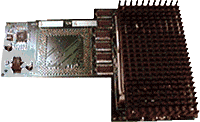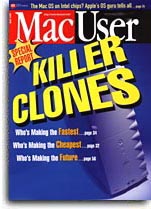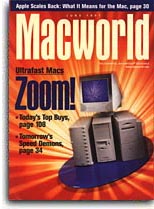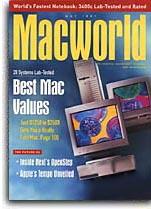|
UCC also offered an attractive software bundle to compete with Apple's freebies. At various times and on various machines, UCC included Connectix VirtualPC, ClarisWorks, Claris Organizer, Claris HomePage, Adobe PageMill, MicroMat TechTool Pro, Synthetic Productions EarSaver, FWB Hard Disk Toolkit PE, FWB RAID Toolkit, FWB CD-ROM Toolkit, Now Up-To-Date, Intuit Quicken SE, Cassady & Greene Conflit Catcher, and others. The bundled software was constantly in flux, prompting a bit of confusion among customers over precisely which applications would be in the box.
It wasn't long before Umax was beating Apple -- and Power Computing, and Motorola -- at the customer satisfaction game. The June '97 issue of Macworld included survey results which showed UCC edging out its competition in a business where the user experience really needed to stand out. Marketing and Quality & Services capitalized on that at every opportunity, and the SuperMac booth at Seybold NY '97 was packed from beginning to end. The multiprocessing capability, massive memory, voluminous internal storage options, multiple SCSI busses, and full complement of PCI slots made the S900 a compelling choice for publishing and graphics professionals, blowing away Apple's own offerings. The Mac press loved what UCC and other cloners were doing.
The mood at UCC's main offices was energetic, focused, and enthused. Margarita Fridays started up in the kitchen not just because everyone liked Margaritas but because it seemed like every week brought some great new milestone, another glowing product review, another favorable lab report from the next hardware design, or something else to celebrate. Everything was happening very quickly, and documenting it now, it's hard to believe that my own time at UCC lasted less than two years. Wasn't there another year in between '97 and '98? "Internet Time" felt too slow to describe it.
Somewhere in the middle of all this, the larger Umax parent corporation decided to build and sell monitors in a short-sighted attempt to be everything to everyone. The trio of models were the decidedly low-end D1500, based on a cheap 15" Hitachi tube, the much nicer 17" D1700, and the gorgeous D2100, based on the same, high-end 21" Mitsubishi display that SuperMac Technology and Radius had previously used in the PressView displays. All three models featured the same basic logo design as the SuperMac computers. Unfortunately, Umax neglected to tell UCC about any of this in advance. The Radius crew had learned years earlier that selling large screen displays was often a losing proposition. Shipping costs were so high, problems were so common, and margins were so low that a single service call on one display could completely wipe out the profit from several displays. The Displays of Doom were very briefly advertised on the SuperMac web site and starred in a supporting role in many SuperMac products shots, but wisdom soon prevailed and they were quietly pulled from the product section. UCC refused to sell them or take any responsibility after that, letting Umax' scanner and PC division figure out what to do with them. Insight into their disposition after that is patchy at best.
UCC engineers were too busy mapping out the company's CHRP and further computer plans to be distracted by monitors. CHRP, or Common Hardware Reference Platform (later known at PowerPC Platform, or PPCP), was the next-generation Mac hardware platform. The use of industry-standard components and technologies promised to ease manufacturing, reduce costs, increase profits, and eliminate a number of performance bottlenecks. UCC's CHRP board design, codenamed Basecamp (which was a step towards the larger "Summit" project), was ahead of Apple's schedule for introduction and exceeded even internal expectations: the dual-604e Basecamp board rated a MacBench 4 score of over 1100, on par with early G3's. The public would get the S910, CacheDoubler for the C-series, and continual speed bumps in the C500, C600, J700, and S900 systems over the next ten months, but the big leap of CHRP was still being kept tightly under wraps.
 
The manufacturing test line and warehousing in Fremont.
With an eye towards increased flexibility, efficiency, and profit, UCC started exploring ways to standardize technologies across the SuperMac line while maintaining clear price and performance differentiation. Using two processor card designs -- a ZIF card for 603-based machines and a larger slot card for 604-based machines -- started to feel impractical and a bit costly. But how could either platform adopt the processor architecture of the other? The C500's pizza-box case simply didn't have room for a 604-style processor card, and the S900 and its descendents couldn't give up that processor card. The answer was to treat the C500 as the lowest common denominator and find a way for the larger systems to adopt the smaller ZIF architecture. A carrier card solution was designed and built for the 604-based systems which had a ZIF socket right on the card. And with UCC's own G3 ZIF and carrier card designs, codenamed Roundtable and Roundtable 2, a single G3 upgrade suddenly existed that could go into any SuperMac machine. Future logic board designs took this even further; the Tanzania 2 board designed for the J710 could accommodate a 603, 604, or G3 (PowerPC 740 or 750) all in the same slot. (The ZIF and carrier card combo was so flexible, UCC later sold its design to upgrade maker MacTell. It has since been adopted by other upgrade manufacturers.)
Although it never made it to production, CacheDoubler was also developed for the S900 and J700, and may have actually inspired the ZIF/Carrier combo design, as it was the only practical way to get CacheDoubler into those machines. Contrary to some notes on the web, however, CacheDoubler for the S900 never shipped in any configuration. By the time it was finally ready, G3 processors were less than a month away in volume -- and despite Apple's refusal to certify a clone with a G3 installed, UCC found a way to ship the "S900Base" with a G3: An S900L was loaded with an old usable-but-sluggish 150MHz 604 processor and a Newer Tech MaxPOWR Pro G3 processor was included outside the box. In an effort to make this appear more unique than it was, the G3 card that Newer Tech provided featured -- for the first six months -- a larger cache and slightly faster L2 speed than other retail Newer Tech cards available.
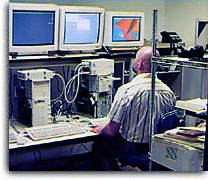 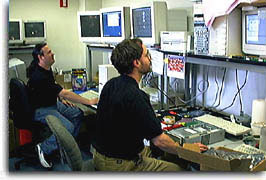 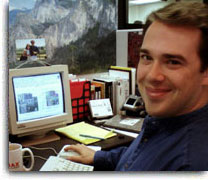
Triple shot: Daryl Isaacs in the original QA Lab, Jordan Ruderman and Steve Spinola in its later incarnation, and Kennedy Brandt in his office.
Some of the confusion over CacheDoubler for the S900 may stem from the fact that UCC's next high-end system, the S910, featured a removable 1MB L2 cache, as opposed to the S900's fixed 512K L2 cache. A number of sources on the web have apparently taken this to mean CacheDoubler, but it was not. It was just a 1MB cache DIMM like any other. Aside from this larger cache, the S910 was also unique in that the order of its PCI slots was reversed, with slot 6 on top and slot 1 at the bottom. The exact benefit of this was a bit obscure, but it aided some multi-card digital video setups. The S910 shipped as the S910/250 and the S910 DP/250 RAID. RAID notwithstanding, it was only a marginal advancement over the S900, and only a few thousand were ever produced. It simply wasn't enough of an evolutionary advance to be a proper replacement for the S900.
The proper replacement for the J700, on the other hand, was clearly the J710. The J700 had always been an odd beast: oversized for a desktop, still with more expandability than most business users really needed, and despite leveraging much of the S900s innards, not nearly as cost-efficient as it should have been. The J710, codenamed "Blizzard," was the perfect successor. Crammed into a C500 case, it took up considerably less space than the J700 yet offered strong performance, an attractive price, and just enough upgradeability to meet most demands. On initial shipment, the ZIF socket would hold a 200MHz 604e, with a 250MHz G3 planned for release in the summer of '98. Video was driven by on-board Matrox hardware with 4MB VRAM (UCC had been looking for an alternative partner to IX Micro, whose future was somewhat in doubt). The 3GB HD and 24x CD-ROM were both IDE. A specialized port on the logic board could accommodate a proprietary internal modem (to be made by E-Tech, another Umax subsidiary), while the Extended Performance PCI slot could host an ordinary 7" PCI card or a Umax E100 card for 10/100BaseT Ethernet and UltraWide SCSI. And the same basic product could be marginally stripped down, loaded with a 603e, and sold as the C510.

The name J710 may have been a bit incongruous. The C500 and C600 made up the logically-paired "C-series" -- different form factors, but the same logic board and performance. There was even less visible separation between the S900 and S910, which were very obviously the "S-series." But the "J-series"? Other than one letter and that both the J700 and J710 were targetted at business users, thay had almost nothing in common. The J700 was resolutely SCSI, used a stripped down Tsunami logic board, and was huge. The J710 featured IDE internal components, was based on Umax' Tanzania 2 logic board design, and occupied little more desktop space than a small monitor.
Naming oddities aside, hardware was looking good, and that was part of the cloners' job. The software picture -- specifically, the OS picture -- was considerably murkier. From its main campus, eight miles southwest in Cupertino, Apple had been threatening for years to develop a next-generation desktop OS that would take the Mac experience to the next level. Alternate bases for the OS ranged from the Be OS (which barely deserves even this little mention) to NeXT's OpenStep, and supposedly, very briefly, even to Microsoft Windows NT. Whatever it would be based on, it was codenamed Copland, and it would hit the world as Mac OS 8. Copland promised to be revolutionary, with protected memory, improved multitasking, a slick new UI -- and a much-delayed release date that had already been pushed back twice. In the meantime, System 7 would continue to be maintained, and even improved a bit. System 7.6 tidied up the unfathomable clutter of the 7.5 range, 7.6.1 was a favorable update to 7.6, and 7.7 promised to be even better. The Mac cloners' current licenses would get them at least one more major update, and they'd be free to petition for a new, Mac OS 8 license in the very near future.
It turned out it was this software picture that would do in the SuperMacs -- and much sooner than anyone at UCC expected.
|


